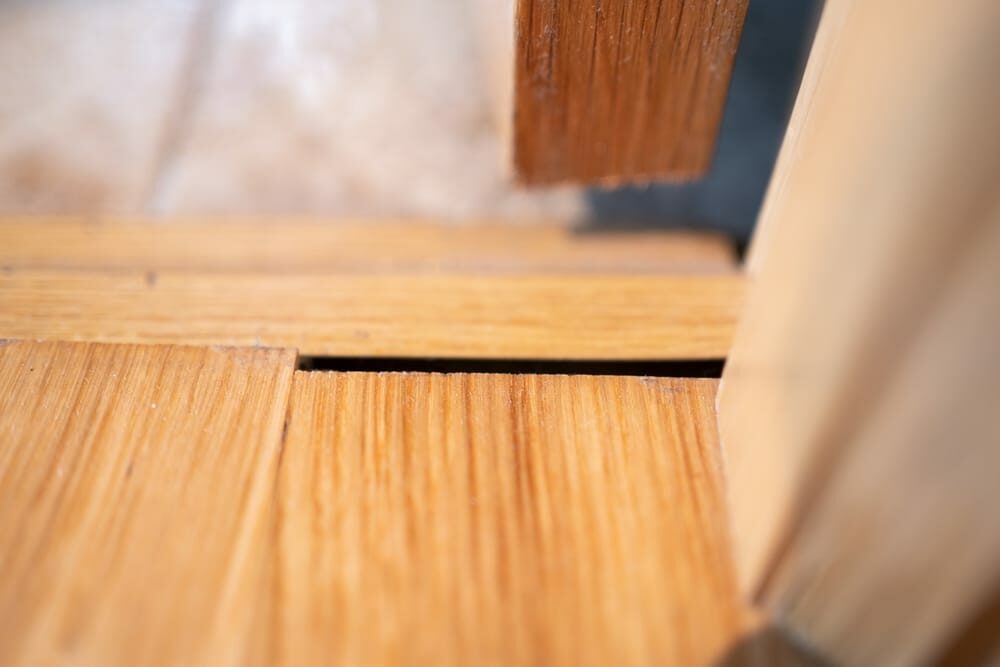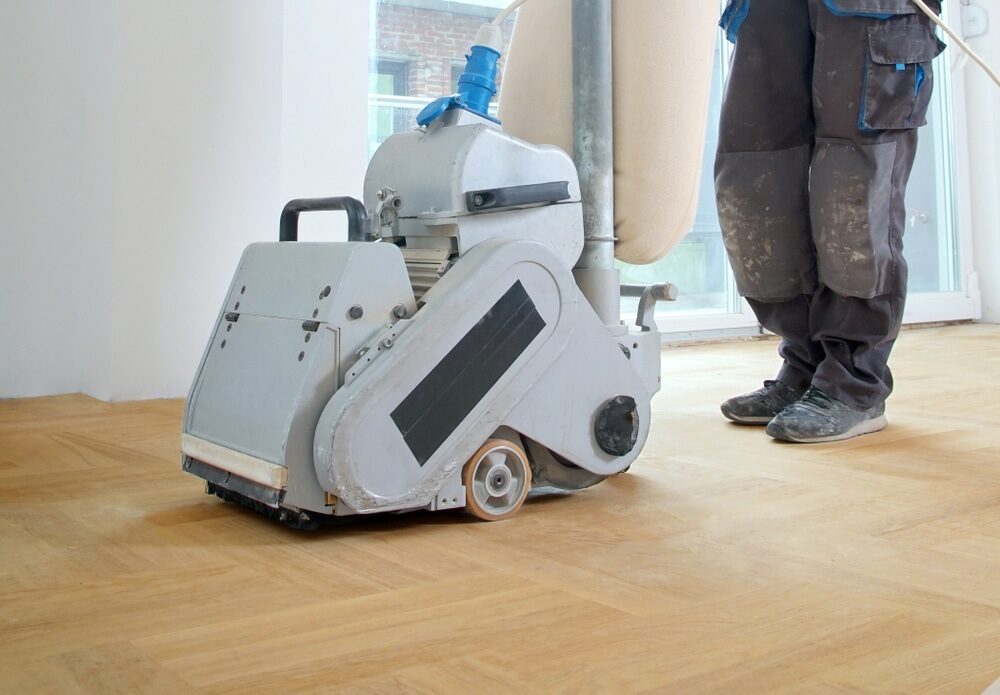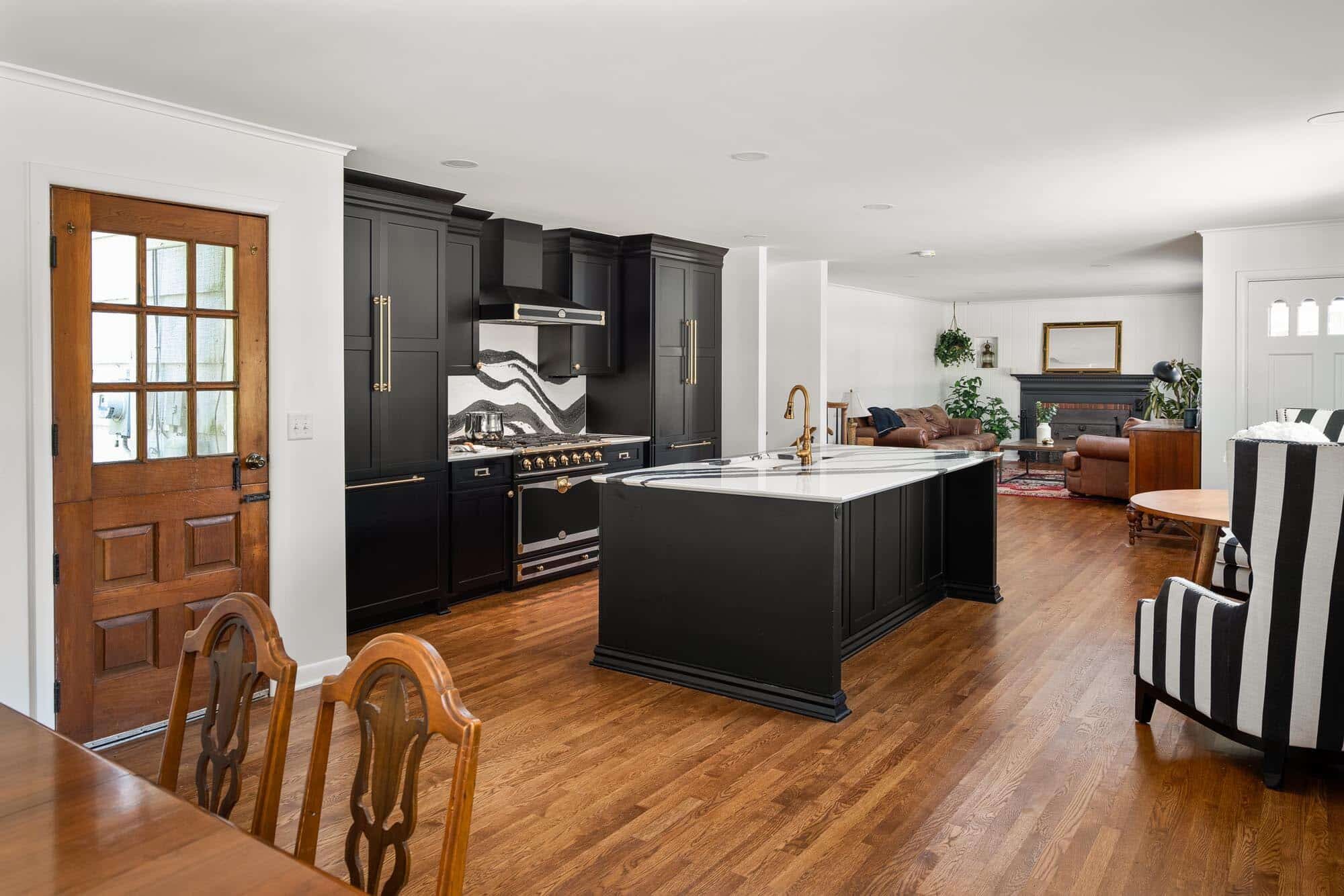London:
Nationwide:
The Pros and Cons of Screening Your Floors
Posted on January 17, 2024
Floor sanding techniques
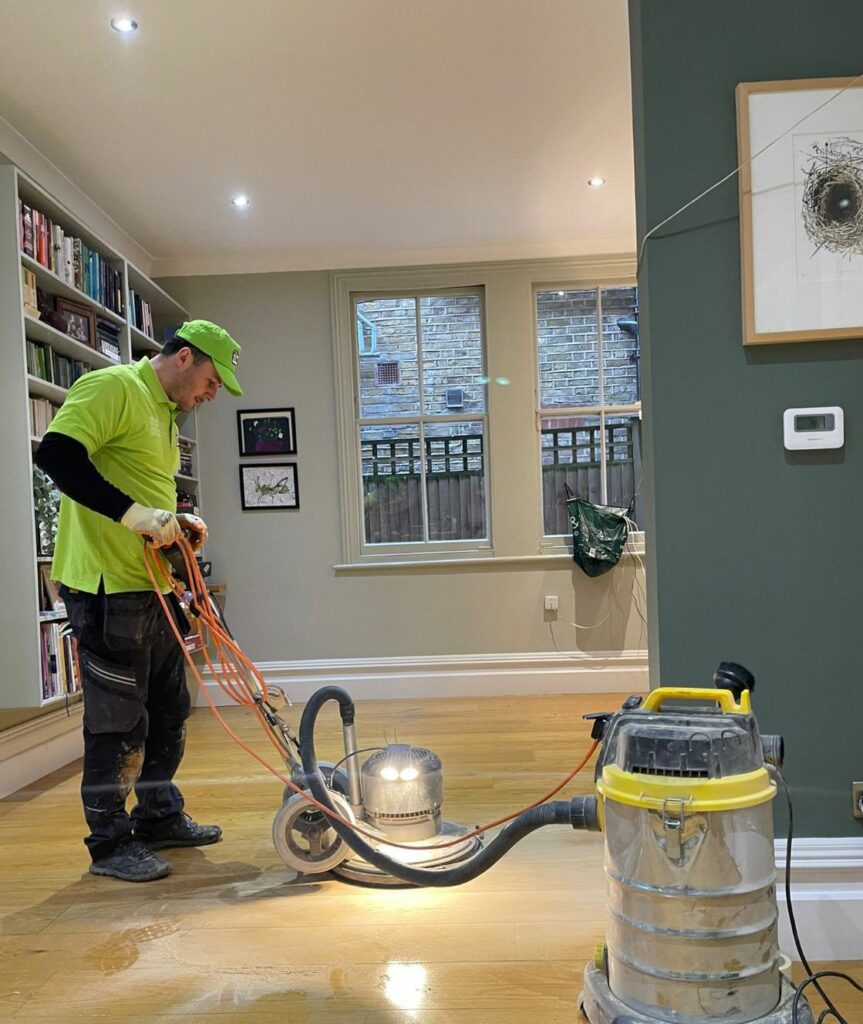
Exploring the Advantages and Disadvantages of Floor Screening: A Comprehensive Guide
Welcome to our comprehensive guide on floor screening, a popular method for maintaining and enhancing the appearance of wooden floors. In this blog post, we aim to delve into the intricacies of floor screening, a process often considered by homeowners and property managers who are looking for an efficient way to revive their hardwood floors without the extensive effort and cost associated with full-scale refinishing.
Floor screening, also known as buffing, is a less-invasive method of restoring the top layer of a wooden floor. It involves lightly sanding the surface to remove the old finish and then applying a new layer of finish. This process can bring back the shine and smoothness to floors that have become dull and worn over time, but without the labour-intensive and costly process of completely sanding down and refinishing the wood.
However, as with any home improvement technique, floor screening comes with its own set of advantages and drawbacks. While it’s a cost-effective and time-saving option compared to full floor refinishing, it’s not suitable for all types of floor damage and may have limitations in terms of durability and finish consistency.
In this blog post, we will explore these aspects in detail, providing you with a balanced view of floor screening. We’ll cover the benefits, such as cost-effectiveness and minimal disruption to your home life, and the limitations, such as its ineffectiveness on deeply scratched or damaged floors. Our goal is to equip you with all the information you need to decide whether floor screening is the right choice for your hardwood floors.
So, whether you’re a homeowner considering a quick refresh for your floors, a DIY enthusiast, or simply curious about this floor maintenance technique, join us as we dive into the world of floor screening. Let’s explore the pros and cons to help you make an informed decision about your home’s flooring needs.
What is floor screening?
Floor screening, also commonly referred to as buffing, is a specific method used in the maintenance and restoration of hardwood floors. It’s a less invasive and more surface-level process compared to full floor refinishing, and it’s primarily aimed at reviving the top layer of the wood flooring.
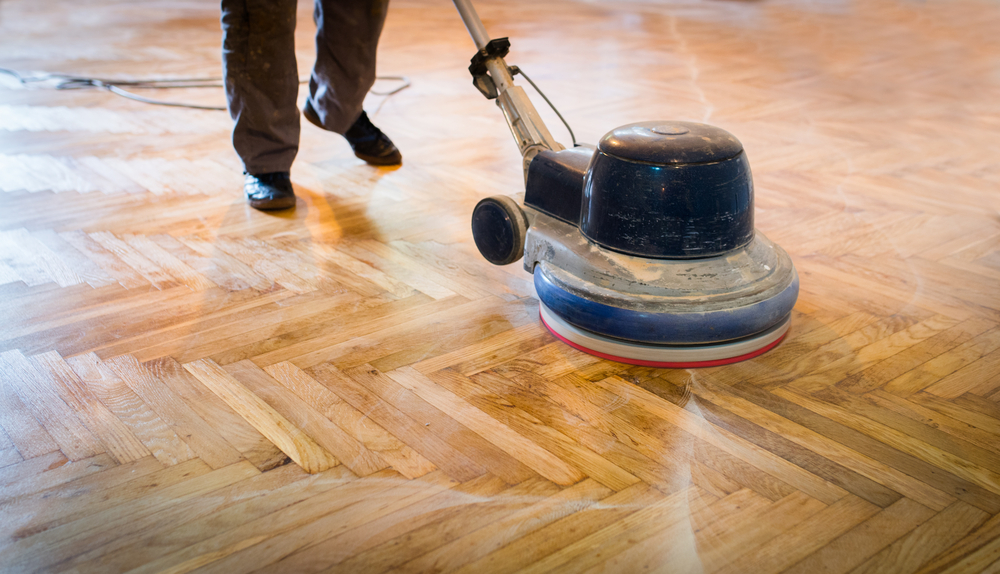
Definition and Basic Process
At its core, floor screening involves the gentle sanding of the floor’s topmost finish layer. This is done using a floor buffer with a fine-grit screening pad. The main purpose of this process is to remove the old finish, such as varnishes or sealants, that may have become dull, scratched, or worn over time. Once the screening is complete, a fresh layer of finish is applied, giving the floor a renewed appearance.
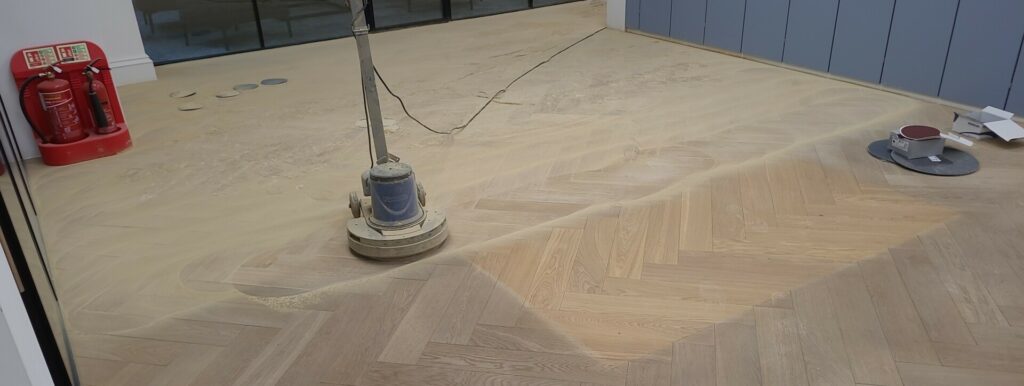
Suitability and Limitations
Screening is most effective on floors that have minor surface imperfections, such as shallow scratches, scuffs, or a lacklustre finish. It’s a popular choice for routine maintenance and is often used as a periodic treatment to extend the life of the floor’s finish.
However, it’s important to note that floor screening is not a remedy for all types of floor damage. Screening cannot solve problems with the wood itself (like warping or buckling), deep scratches, gouges, or stains that have seeped into the wood. In these cases, more intensive treatments like complete refinishing or repairs might be necessary.
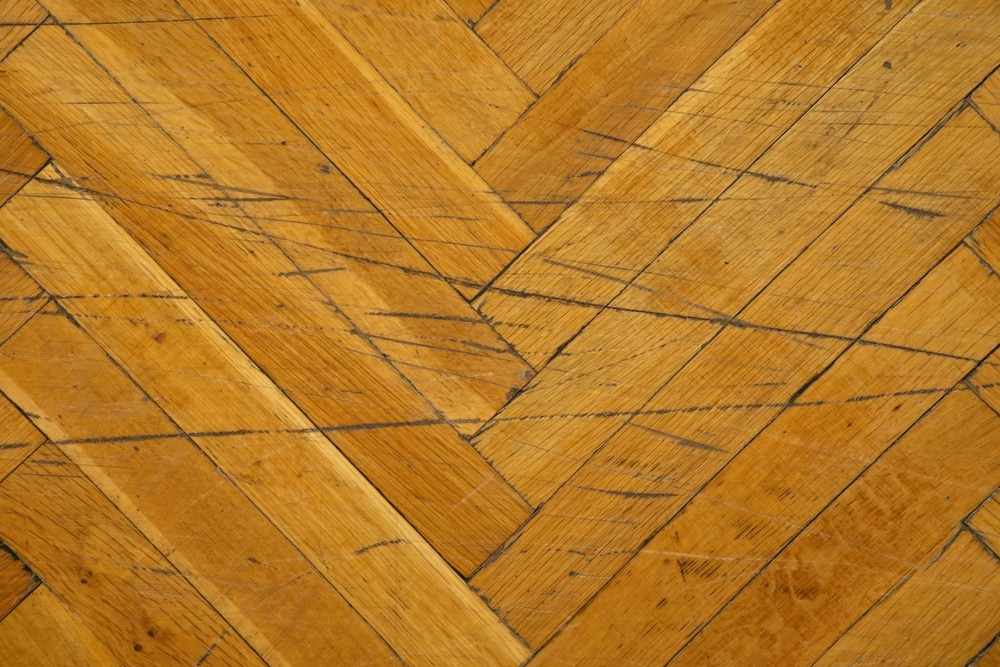
Types of Floors Suitable for Screening
While primarily used for hardwood floors, screening can be performed on various types of wooden flooring, including solid hardwood, engineered wood, and sometimes even laminated surfaces. The key factor is the condition of the floor’s top layer and the type of finish that was previously applied.
Floor screening is a valuable method for maintaining and rejuvenating floors without the need for a full-scale refinishing project. It’s a cost-effective and time-efficient solution for floors that just need a little sprucing up, rather than a complete overhaul. In the next sections, we’ll delve deeper into the advantages and disadvantages of this technique to give you a better understanding of its practical applications.
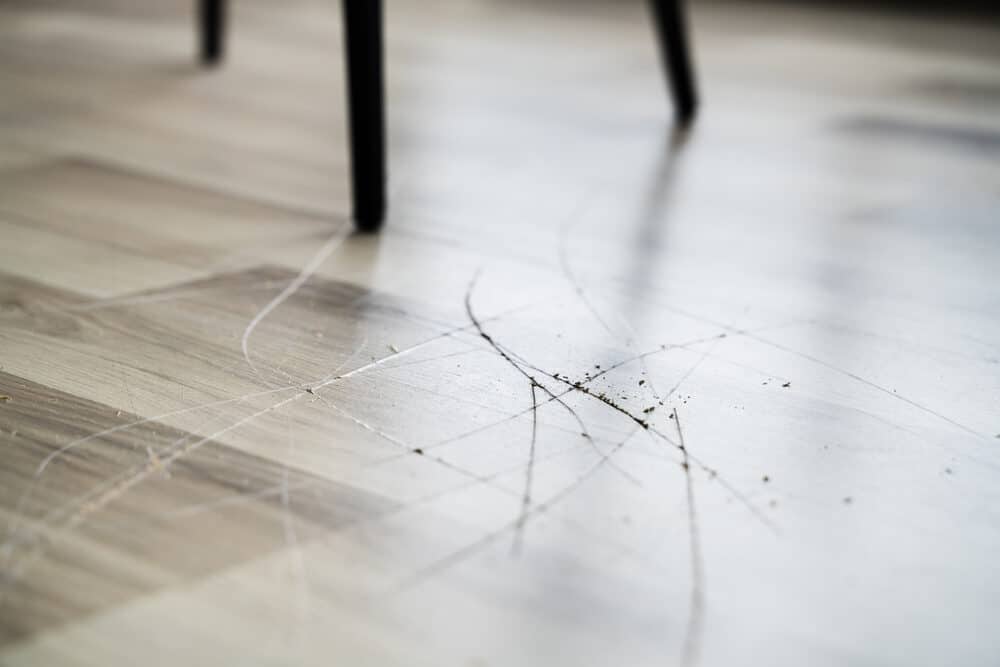
Pros of Floor Screening
Floor screening offers several advantages, making it an attractive option for homeowners and property managers looking to revitalise their hardwood floors. Here are some of the key benefits:
Enhancing Floor Appearance
- Restoring Shine and Lustre: Screening effectively removes the top layer of grime and old finish, revealing the underlying beauty of the wood. It revitalises the floor’s appearance, bringing back its original shine and smoothness.
- Evening Out Surface Imperfections: Minor scratches and scuffs that accumulate over time can be smoothed out, giving the floor a more uniform and aesthetically pleasing look.
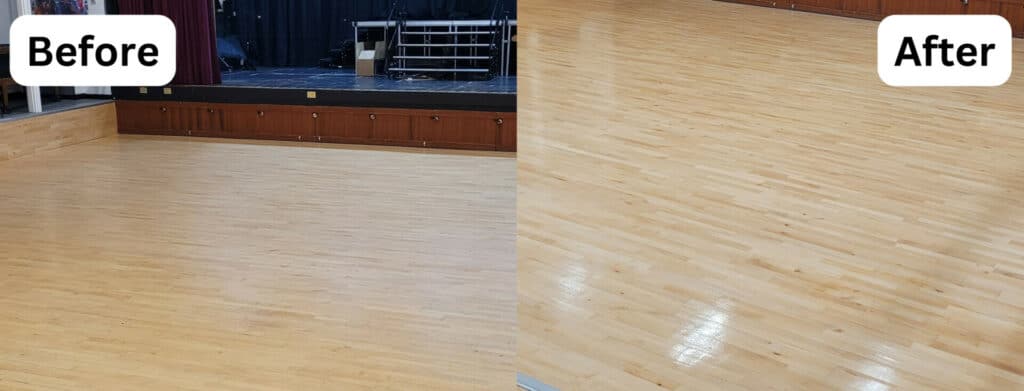
Cost-Effectiveness Compared to Refinishing
- Lower Expense: Screening is significantly less expensive than a full floor refinishing project. Since it’s a less labour-intensive process that requires fewer materials, it’s a more budget-friendly option for maintaining the appearance of your floors.
- Extending Floor Life: Regular screening can prolong the life of your hardwood floors, delaying the need for more expensive and extensive refinishing.

Time Efficiency
- Quick Process: Unlike full refinishing, which can take several days to complete and cure, floor screening is a relatively quick process. It typically requires less time to perform and for the new finish to dry, minimising the disruption to your daily routine.
- Immediate Use of Space: The quicker drying time means that you can use the screened area sooner, reducing inconvenience.
Environmental Benefits
- Less Waste Generation: Since screening doesn’t involve sanding down the wood, there’s significantly less sawdust and waste produced. This makes it an environmentally friendly option.
- Preservation of Resources: By extending the life of the existing wood floor, screening reduces the need for new flooring materials, thereby conserving resources.
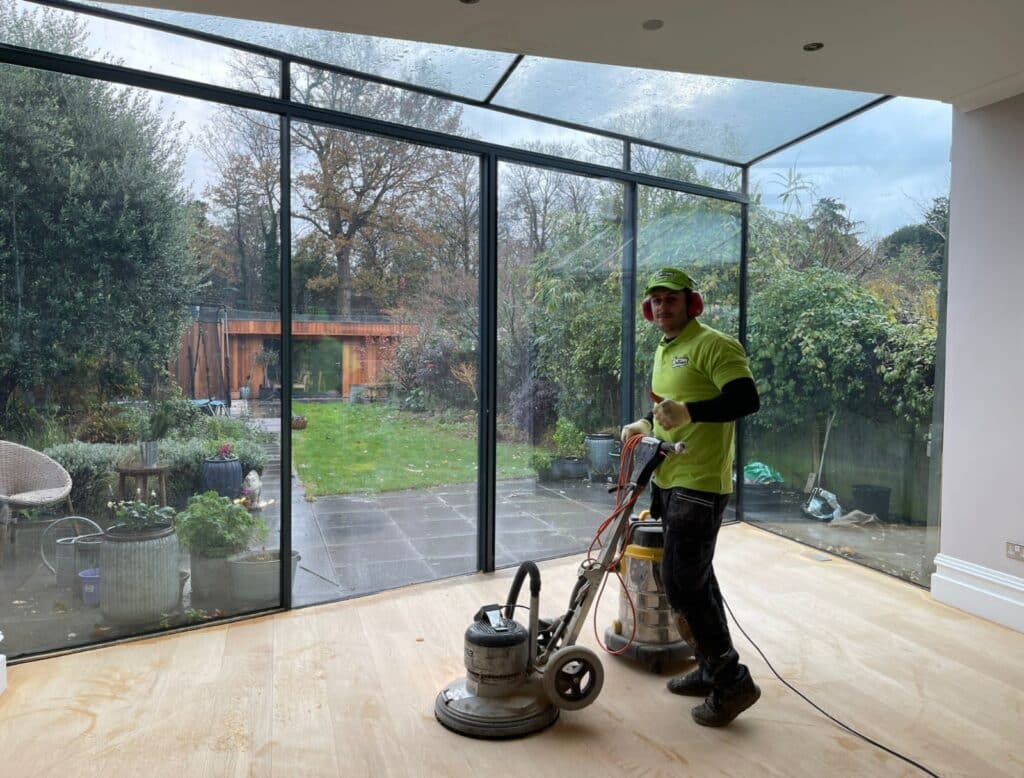
Flexibility in Finish Choices
- Variety of Finishes: Post-screening, you have the option to choose from various types of finishes (e.g., matte, satin, gloss) to match your decor or personal preferences.
- Customisation: Screening allows for the application of different stains or finishes, offering a degree of customisation without the need for a complete floor overhaul.
Less invasive process
- No Major Structural Changes: Since screening only affects the top layer of the floor, the integrity and character of the original wood are maintained.
- Minimal Noise and Dust: The process is less noisy and dusty compared to full floor sanding and refinishing, making it more suitable for occupied homes or commercial spaces.
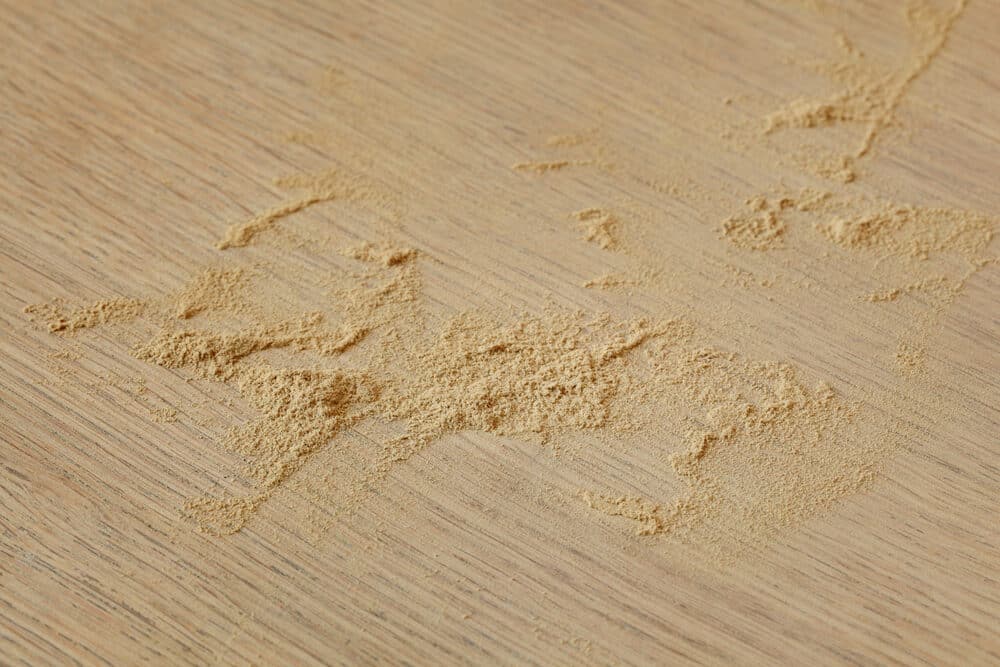
Cons of Floor Screening
While floor screening has several advantages, it’s also important to be aware of its limitations and potential drawbacks. Here are some of the main cons associated with this process:
Limitations on Damaged Floors
- Ineffectiveness on Deep Damage: Screening is not suitable for floors with deep scratches, gouges, or significant wear. It only addresses surface-level imperfections.
- Inability to Remove Deep Stains: If the wood is stained or discoloured beyond the very top layer, screening will not be effective in removing these deeper blemishes.
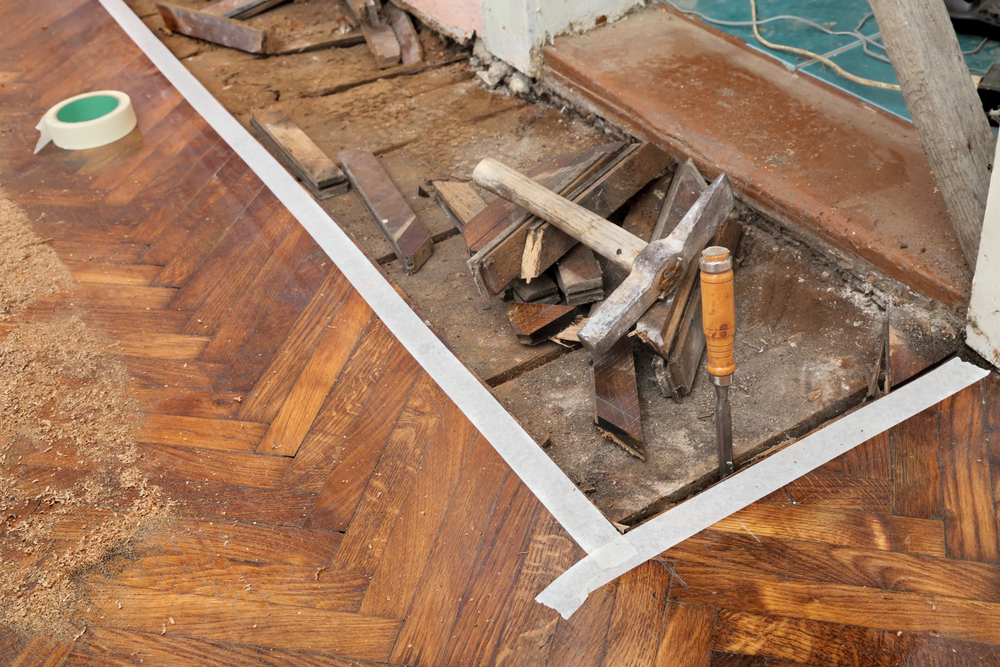
Frequency of maintenance required
- Shorter Duration of Results: Since screening only involves working on the top layer, the results might not last as long as a full refinish. This may require more frequent maintenance to keep the floors looking their best.
- Regular Treatment Needed: For high-traffic areas, regular screening might be necessary to maintain the floor’s appearance, adding to the long-term maintenance cost.
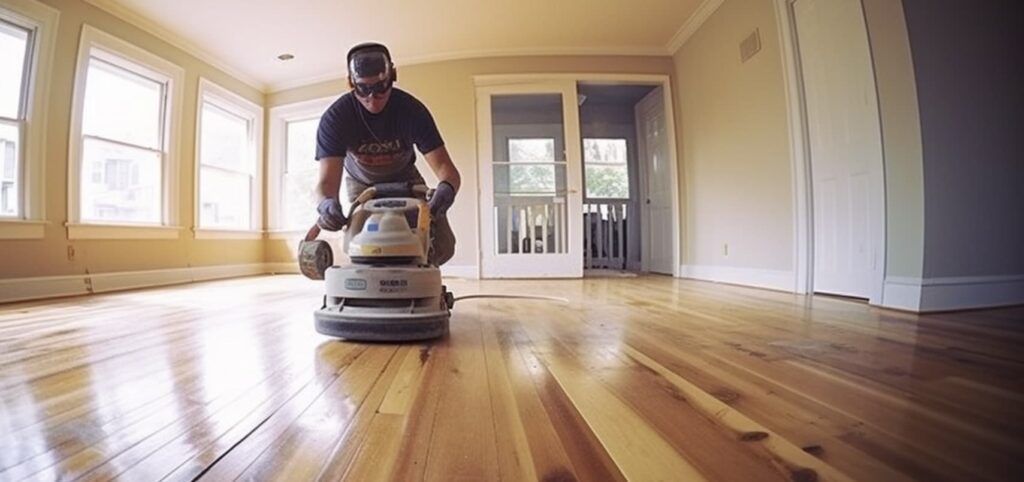
Potential for Inconsistent Results
- Uneven Finishing: If not done correctly, screening can lead to uneven finishes, with some areas appearing glossier or duller than others.
- Skill Level Required: Achieving a uniform look requires a certain level of skill and experience. DIY efforts might result in less-than-satisfactory outcomes.
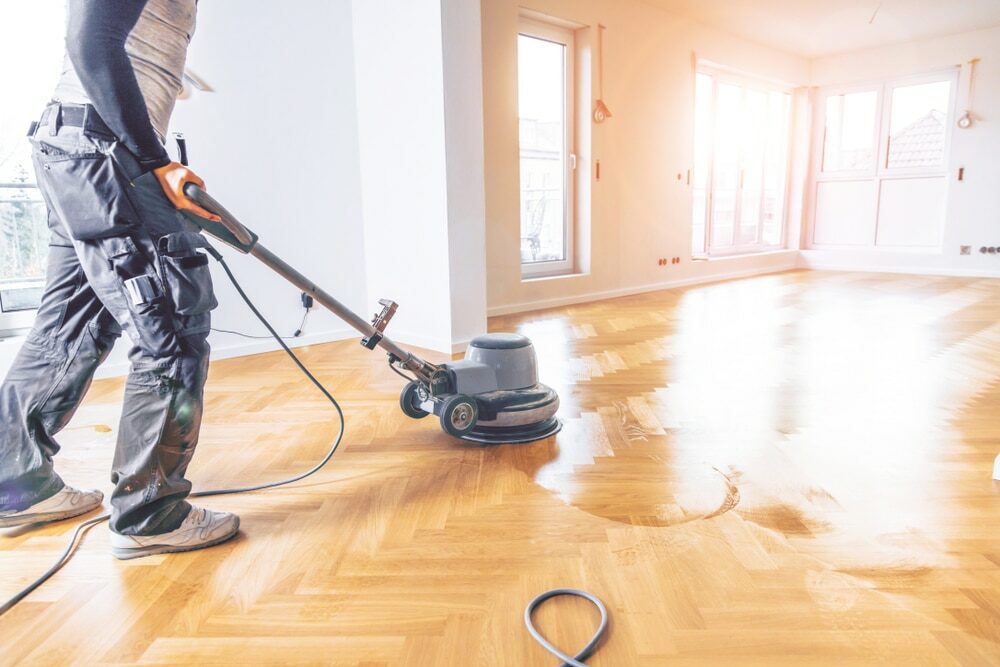
Limited Effectiveness on Certain Finishes
- Incompatibility with Some Finishes: Not all types of floor finishes are suitable for screening. For example, floors with wax-based finishes or certain penetrating oils might not respond well to the process.
- Requirement for Specific Types of Finishes: After screening, certain types of finishes must be used, which may not always align with the homeowner’s preferences or the floor’s original look.
Potential Risk to Floor Integrity
- Slight Reduction in Surface Thickness: Even though screening is a surface-level process, repeated screenings over time can gradually wear down the top layer of the wood.
- Risk of Damage from Equipment: Improper use of the screening equipment can potentially damage the floor, especially if it’s not handled by a professional.
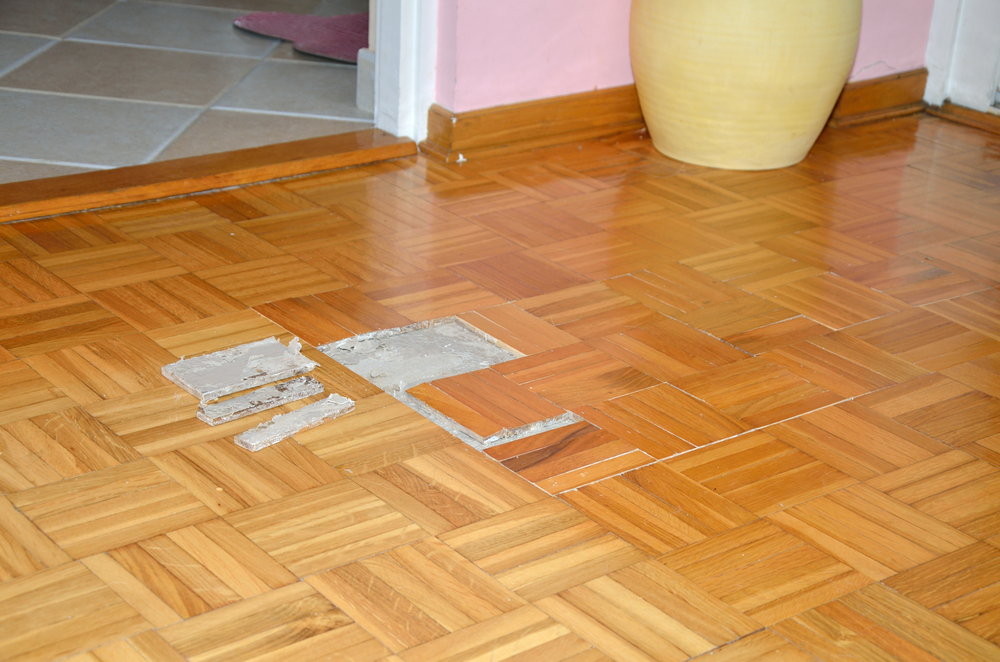
Dust and Cleanup
- Some Dust Production: Despite being less messy than full refinishing, screening still produces some dust, requiring cleanup and possibly affecting indoor air quality temporarily.
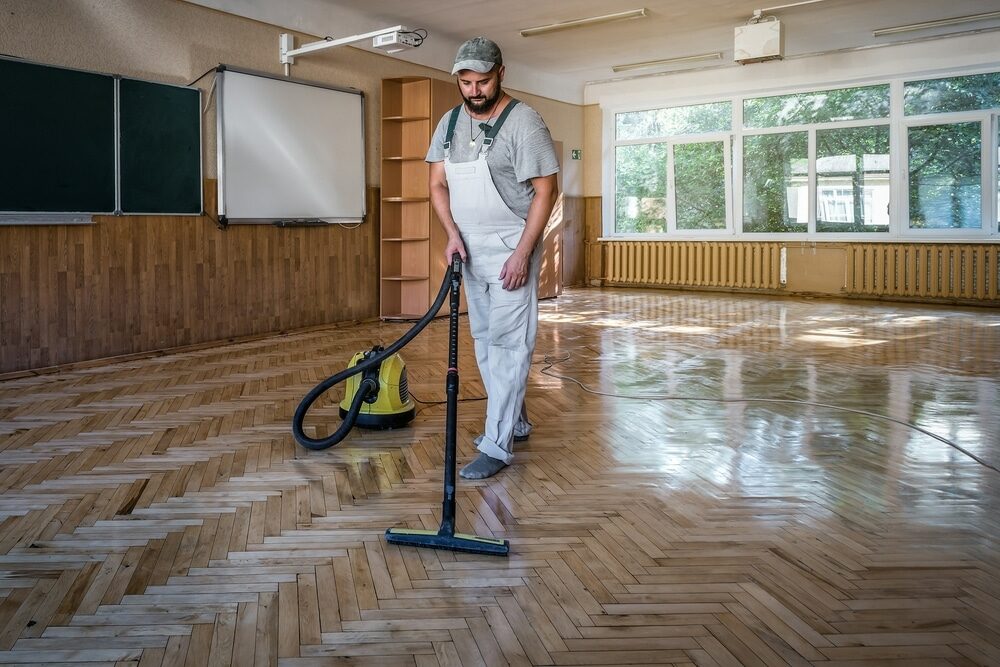
Limited repair capability
- Cannot Address Structural Issues: Screening does not address structural problems like warping, buckling, or issues with the subfloor.
Comparing Floor Screening to Other Floor Treatments
When considering ways to maintain or rejuvenate hardwood floors, it’s important to understand how floor screening compares to other common treatments like full floor refinishing and floor replacement. Each method has its own unique benefits and drawbacks, suited for different conditions and requirements.
Floor screening vs. refinishing
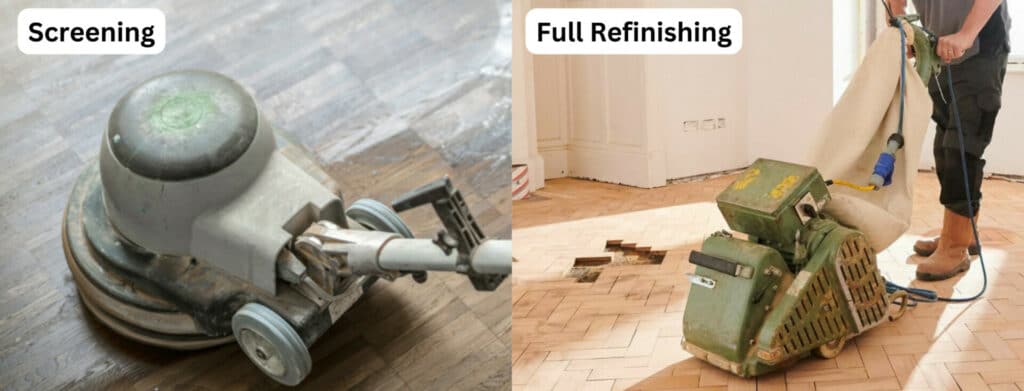
Process and intensity
- Screening is a less invasive process that involves lightly sanding the top layer of the floor and applying a new finish. It addresses superficial scratches and wear.
- Refinishing: This involves sanding the floor down to the bare wood and removing all the existing finish and top layer of wood. It’s used for more extensive damage, deep scratches, and significant wear.
Cost and time
- Screening is generally more cost-effective and quicker than refinishing. The process and drying time are shorter, causing less disruption.
- Refinishing is more expensive and time-consuming due to the labour-intensive process. The floor needs more time to dry and cure after refinishing.
Longevity and Durability
- Screening: Offers a temporary solution; it might need to be done more frequently than refinishing.
- Refinishing provides a more durable and long-lasting result. It’s a more permanent solution for damaged floors.
Appearance and Customisation
- Screening is limited in terms of changing the floor’s colour or repairing significant aesthetic flaws.
- Refinishing: This allows for changing the wood stain colour and can significantly improve the appearance of severely worn floors.
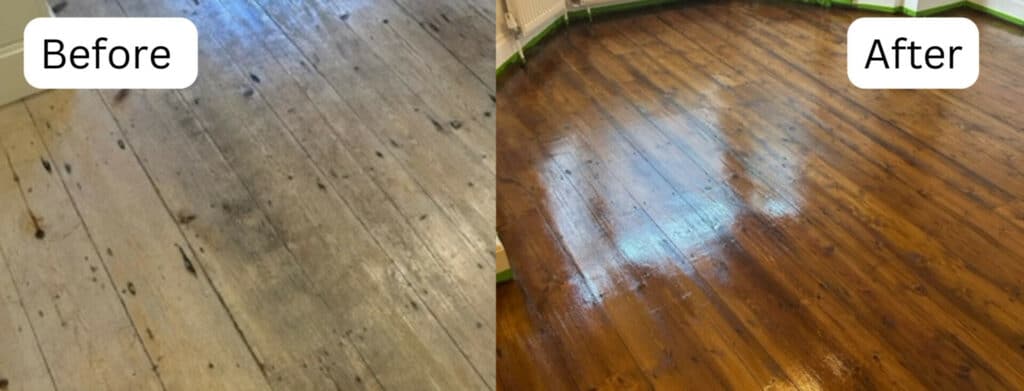
Floor screening vs. replacing
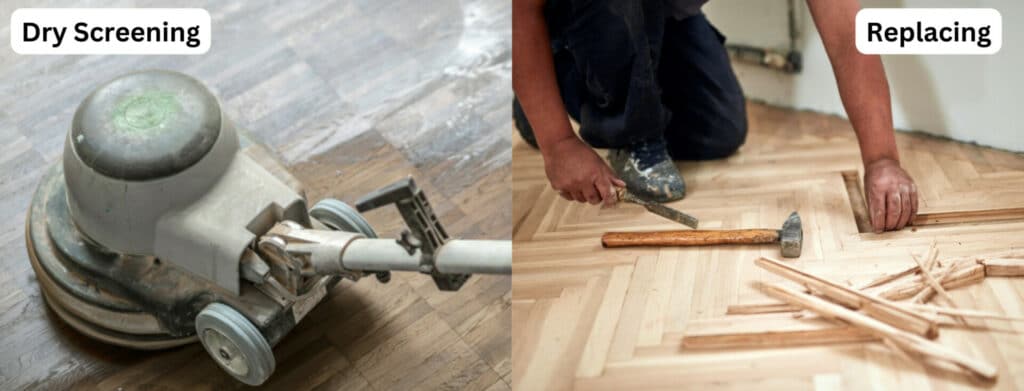
Nature of the Treatment
- Screening is an enhancement and maintenance procedure that is not suitable for addressing structural problems or severe damages.
- Replacing: This involves completely removing the old flooring and installing new material. It’s necessary for floors that are beyond repair.
Cost Implication
- Screening is much more cost-effective than replacing the entire flooring.
- Replacing: This involves a higher cost due to the purchase of new materials and the labour involved in installation.
Time and convenience
- Screening: quick and less disruptive, usually completed within a day or two.
- Replacing: more time-consuming and disruptive, as it involves significant construction work.
Impact on Home Value
- Screening improves the appearance and extends the life of the existing floor, maintaining home value.
- Replacing: This can significantly increase home value, especially if the old floors were in poor condition or outdated.
Expert Opinions on Floor Screening
Gathering insights from industry professionals can provide valuable perspectives on the effectiveness and suitability of floor screening. Here’s a compilation of expert opinions that highlight various aspects of this process:
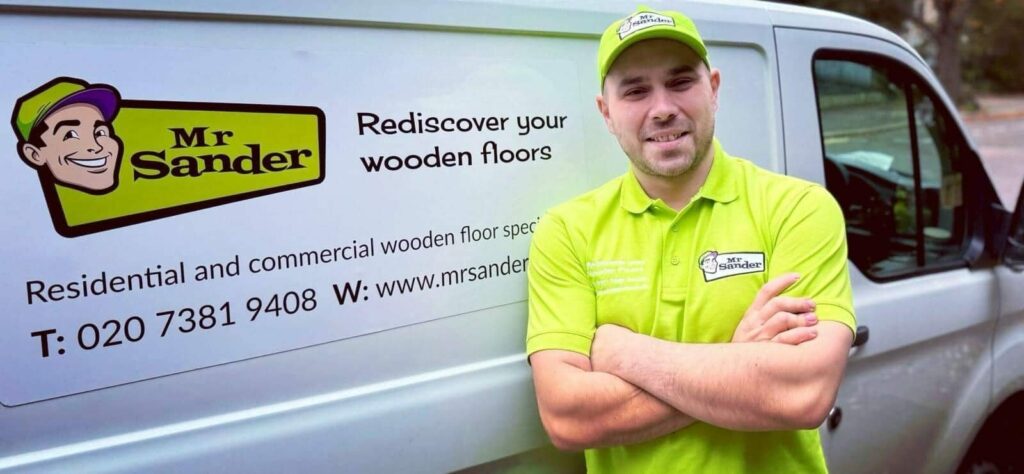
Suitability for Different Floor Conditions
- Selective Application: Experts often recommend floor screening for hardwood floors that have lost their sheen but are otherwise in good condition. It’s not advisable for floors with deep scratches, warping, or structural issues.
- Assessment First: Professionals typically suggest a thorough assessment of the floor’s condition before deciding on screening. This helps in determining whether screening will be effective or if more intensive treatment is needed.
Comparison with Full Refinishing
- Cost-Benefit Analysis: Many flooring specialists highlight the cost-effectiveness of screening compared to full refinishing. Screening is a fraction of the cost and is often sufficient for regular maintenance.
- Longevity Expectations: While acknowledging that screening is less durable than refinishing, experts emphasise its role in regular floor maintenance, extending the life of the finish and delaying the need for refinishing.
DIY vs. professional services
- Skill Level Considerations: There’s a consensus among professionals that while DIY screening is possible, it requires a certain skill level to avoid uneven finishes. They often recommend professional services for consistent and high-quality results.
- Equipment and Experience: Experts point out that professionals have access to better equipment and possess the experience to handle various floor types and conditions, reducing the risk of damage.
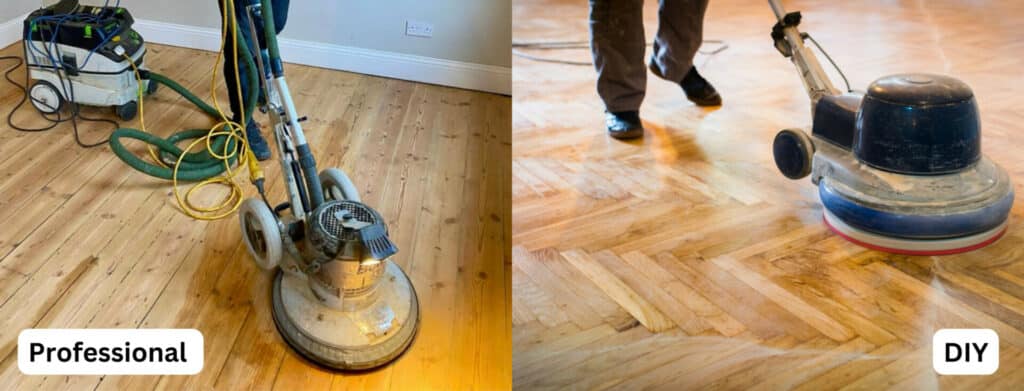
Environmental Considerations
- Eco-Friendly Option: Environmental experts appreciate floor screening for its reduced impact on waste generation and resource use. Since it involves minimal material removal, it’s considered a more sustainable option compared to full refinishing or replacement.
Frequency and timing
- Regular Maintenance Advice: Flooring professionals often suggest incorporating screening into regular floor maintenance schedules, especially for high-traffic areas, to maintain the floor’s appearance and prolong its life.
- Timing Recommendations: Some suggest screening every few years, depending on the level of foot traffic and the floor’s exposure to wear and tear.
Customisation and aesthetic choices
- Finish Flexibility: Design experts point out that screening allows homeowners to change the finish type (e.g., matte, satin, gloss) without the need for a complete refinishing, offering some level of customisation.
Limitations and precautions
- Awareness of Limitations: Flooring experts consistently emphasise that screening is not a miracle solution for all floor problems. Being aware of its limitations is crucial to setting realistic expectations.
- Care with Older Floors: There’s a note of caution when it comes to screening very old or historic wood floors, as they may require more delicate handling.
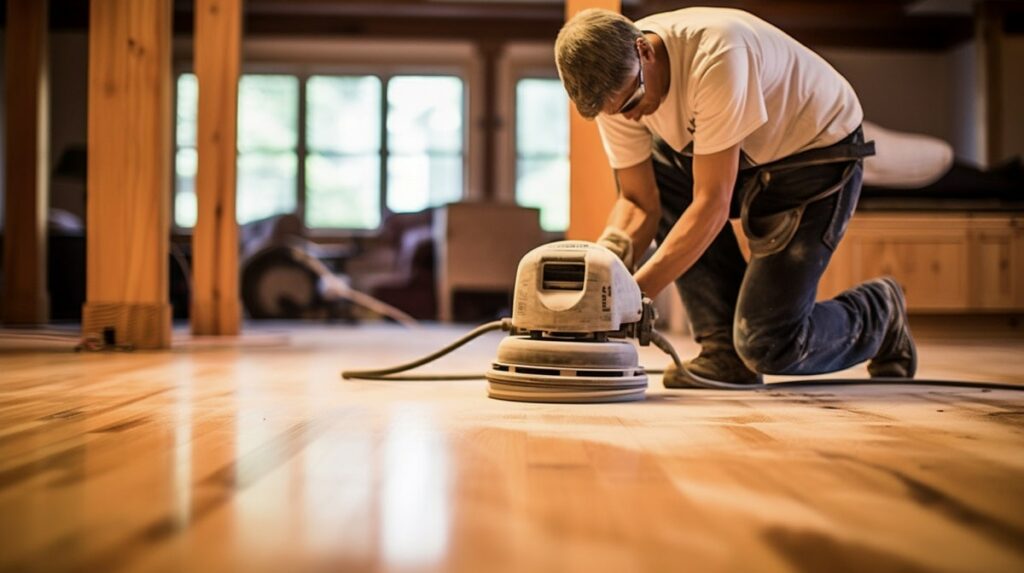
Conclusion
As we wrap up our exploration into the world of floor screening, it’s clear that this process holds significant value in the realm of hardwood floor maintenance. Floor screening emerges as a practical, cost-effective, and environmentally friendly method suitable for reviving floors that have lost their sheen due to regular wear and tear. Its ability to enhance the appearance of a floor with minimal effort and expense makes it an attractive option for many homeowners.
However, it’s essential to acknowledge the limitations of floor screening. It’s not a one-size-fits-all solution and is ineffective for floors with deep scratches, structural damage, or significant wear. The process is best suited for superficial maintenance and cannot replace the comprehensive restoration that comes with full floor refinishing or replacement. Homeowners should carefully assess the condition of their floors and consider professional advice to determine if screening is the right choice for their specific needs.
The comparison of floor screening with other treatments like refinishing and replacement highlights its position as an intermediate maintenance step. It’s an ideal choice for extending the life of a floor’s finish and delaying more invasive and costly procedures. However, it’s not a substitute for thorough refurbishment when the floor’s condition calls for it.
Expert opinions reinforce the value of floor screening in the right circumstances. They emphasise the importance of professional assessment and execution to ensure high-quality results, especially for those who might not have the skills or experience for a DIY project. Additionally, the environmental benefits of screening, such as reduced waste generation and resource conservation, align with growing eco-conscious trends in home maintenance.
In conclusion, floor screening is a valuable tool in the homeowner’s arsenal for keeping hardwood floors looking their best. When used appropriately, it can effectively rejuvenate a floor’s appearance, maintain its condition, and extend its lifespan, all while being mindful of cost and environmental impact. However, it should be viewed as part of a broader floor maintenance strategy, complementing other treatments and tailored to the specific needs and conditions of the flooring.

Sanding
We provide virtually dust-free sanding with our continuous belt machinery with mobile extraction units, giving you a safer environment for your family.
Oiling
This organic finish not only adds beauty to your home but also has exceptional water-repellent characteristics, making it easier to clean and maintain.
Waxing
This natural floor finish offers the softest and most mellow appearance – and leaves your floor able to breath.
Buffing
Using soft buffing machines (and hand-polishing where required) will bring a wonderful sheen to your newly-finished floor.
Repairs
We offer a full assessment of your wooden floors to determine what repairs are needed to provide the perfect working surface for the later stages of sanding, staining and sealing.
Restoration
We offer a comprehensive restoration process designed to address floors that are improperly fitted or damaged over time through wear and tear.
Request a fixed price quote for your wood floor restoration now
Simply enter your postcode below to get started.
Services
Wood Floor Sanding Wood Floor Restoration Wood Floor Scratch Repair Squeaky Wood Floor Repair Parquet Floor Sanding Parquet Floor Restoration Commercial Floor Sanding Church Floor Sanding Community Centre Floor Sanding School Floor Sanding Gap Filling Gap Filling with ResinCopyright © Mr Sander®
Privacy & Cookies Terms & Conditions Complaints Procedure Cancellation Rights Sitemap